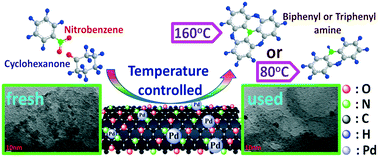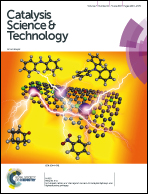N/O-doped carbon as a “solid ligand” for nano-Pd catalyzed biphenyl- and triphenylamine syntheses†
Abstract
A series of N/O-doped porous carbon supported nanopalladium catalysts have been successfully prepared, in which the N/O doped carbons were controllably produced via polypyrrole/furan synthesis followed by carbonization. These catalysts exhibit good performance in biphenylamine and triphenylamine syntheses with nitrobenzene and cyclohexanone as starting materials. Their catalytic activity can be tuned efficiently by the N/O functional groups on the carbon surface. TEM, XRD, XPS and laser Raman methods were applied to probe the structure of these catalysts. These results indicate that the Pd nanoparticles were supported on N/O-doped porous carbon via the “coordination” between Pd nanoparticles and N/O functional groups including O–C![[double bond, length as m-dash]](https://www.rsc.org/images/entities/char_e001.gif) O, C
O, C![[double bond, length as m-dash]](https://www.rsc.org/images/entities/char_e001.gif) N and tertiary nitrogen, and better catalytic performance was obtained if carbon with the highest N-species loading was used as the support. In addition, a mechanistic study proved that the reaction starts with the catalytic reduction of nitrobenzene with cyclohexanone as the hydrogen source. During this reaction, aniline was formed and the cyclohexanone was transformed into phenol. Then biphenylamine and triphenylamine were generated through the reaction of aniline and cyclohexanone. This work should facilitate the controllable preparation of carbon supported nanocatalysts with specific activity, and open up a promising pathway for the development of new methodologies for N-containing fine chemical synthesis.
N and tertiary nitrogen, and better catalytic performance was obtained if carbon with the highest N-species loading was used as the support. In addition, a mechanistic study proved that the reaction starts with the catalytic reduction of nitrobenzene with cyclohexanone as the hydrogen source. During this reaction, aniline was formed and the cyclohexanone was transformed into phenol. Then biphenylamine and triphenylamine were generated through the reaction of aniline and cyclohexanone. This work should facilitate the controllable preparation of carbon supported nanocatalysts with specific activity, and open up a promising pathway for the development of new methodologies for N-containing fine chemical synthesis.

- This article is part of the themed collection: 2017 Catalysis Science & Technology HOT Articles


 Please wait while we load your content...
Please wait while we load your content...